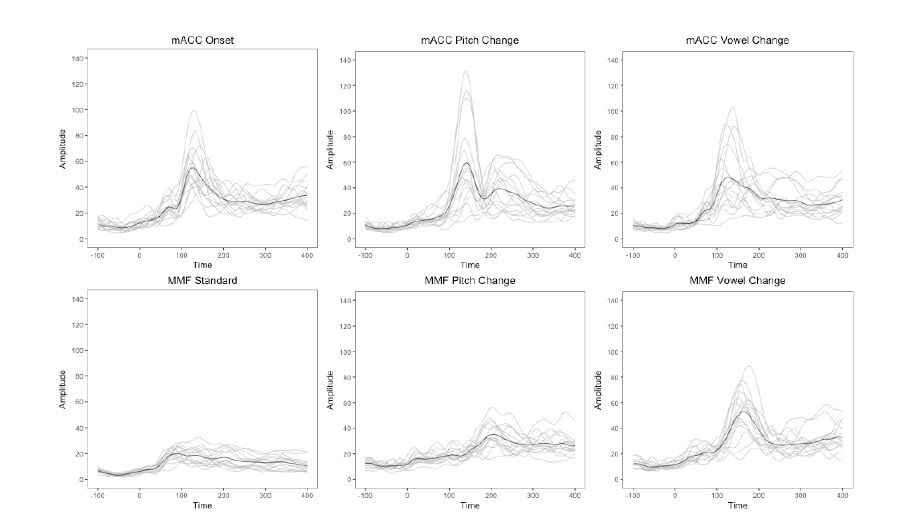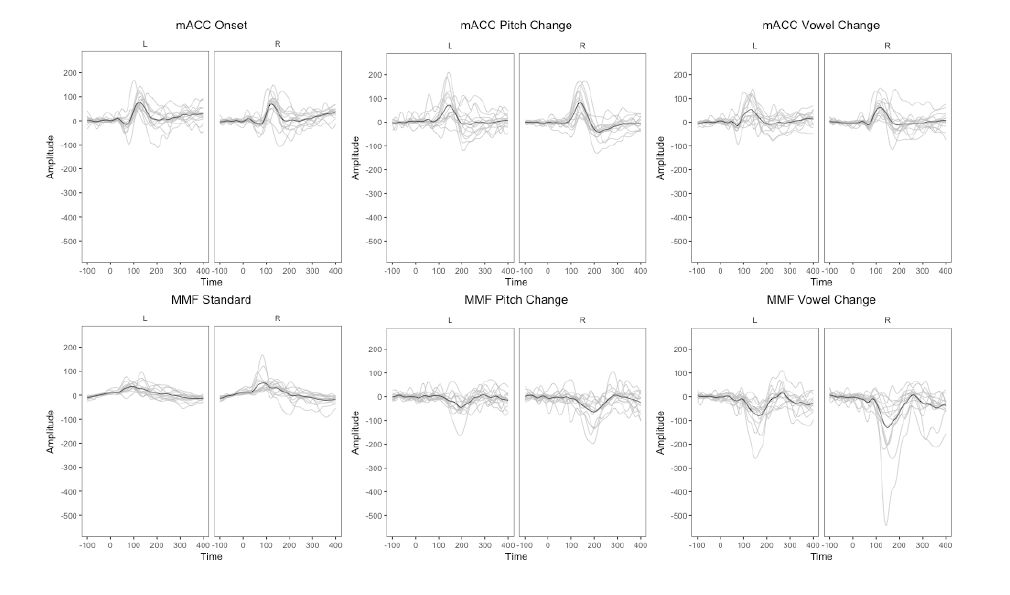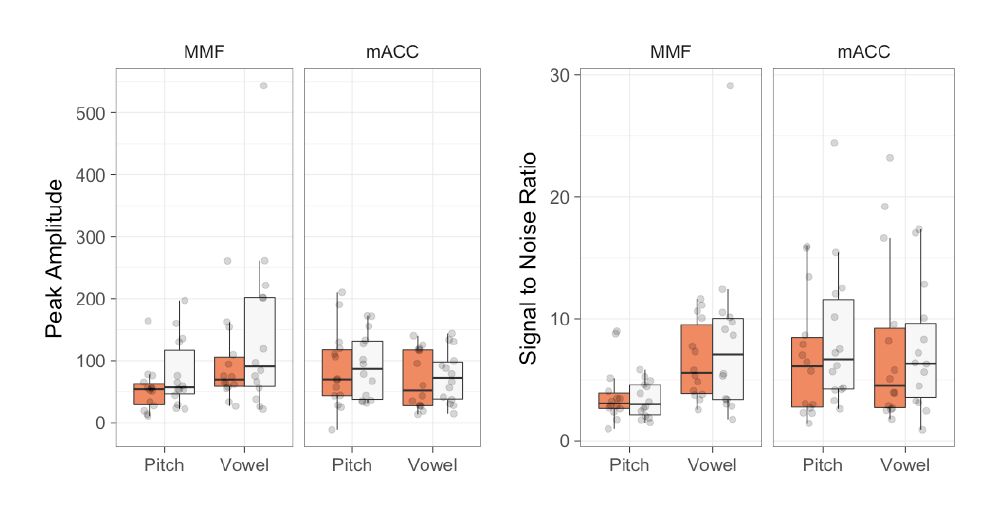The Acoustic Change Complex (ACC), a P1-N1-P2-like event-related response to changes in a continuous sound, has been suggested as a reliable, objective, and efficient test of auditory discrimination. We used magnetoencephalography to compare the magnetic ACC (mACC) to the more widely used mismatch field (MMF). Brain responses of 14 adults were recorded during mACC and MMF paradigms involving the same pitch and vowel changes in a synthetic vowel sound. Analyses of peak amplitudes revealed a significant interaction between stimulus and paradigm: for the MMF, the response was greater for vowel changes than for pitch changes, whereas, for the mACC, the pattern was reversed. A similar interaction was observed for the signal to noise ratio and single-trial analysis of individual participants’ responses showed that the MMF to Pitch changes was elicited less consistently than the other three responses. Results support the view that the ACC/mACC is a robust and efficient measure of simple auditory discrimination, particularly when researchers or clinicians are interested in the responses of individual listeners. However, the differential sensitivity of the two paradigms to the same acoustic changes indicates that the mACC and MMF are indices of different aspects of auditory processing and should, therefore, be seen as complementary rather than competing neurophysiological measures.
1.
Introduction
Integrable evolution equations are very common and play a key role in nonlinear science, as shown in studies like [1,2,3]. Specifically, the Korteweg-de Vries (KdV) equation, which comes from fluid dynamics, explains how waves with slight dispersion and small amplitude evolve in media with quadratic nonlinearity [2,4]. Additionally, the nonlinear Schrödinger (NLS) equation describes the behavior of waves that are slightly nonlinear and quasi-monochromatic in media with cubic nonlinearity [3,5,6]. Moreover, the derivative nonlinear Schrödinger (DNLS) equation is used to describe Alfvén waves in plasmas with low-β values, as well as large-amplitude waves that run parallel to the magnetic field [7,8,9]. These equations are mathematically integrable, meaning they can be solved exactly.
Recently, Ablowitz and Musslimani introduced the following parity time (PT)-symmetric nonlocal NLS equation and derived its explicit solutions[10]:
where ε=±1 denotes the focusing (+) and defocusing (−) nonlinearity, and the asterisk denotes the complex conjugate. The PT symmetry implies that the self-induced potential V(x,t)=u(x,t)u∗(−x,t) fulfills the relation V∗(−x,t)=V(x,t), while the nonlocality indicates that the value of the potential V(x,t) at x requires the information on u(x,t) at x, as well as at −x[11,12,13]. Since Eq (1.1) exhibits properties akin to those of the standard NLS equation, such as integrability in the Lax and inverse scattering senses, a significant amount of theoretical research has been conducted[14,15,16], and the study on the equations has extended to higher-order and coupled ones[17,18,19]. Furthermore, there has been experimental evidence observed in the fields of optics and materials science[20,21,22].
Subsequently, some other nonlocal integrable equations have been proposed[23,24,25]. One of these nonlocal equations is the nonlocal DNLS equation[8,9],
which is obtained from the standard DNLS equation by replacing |u|2u with u(x,t)2u∗(−x,t), and the conserved density V(x,t)=u(x,t)u∗(−x,t) satisfies the relation V∗(−x,t)=V(x,t). In [8], hierarchies of nonlocal DNLS-type equations have been derived utilizing Lie algebra splitting, with the specific nonlocal DNLS equation being termed as nonlocal DNLSI. Zhou[9] formulates the 2n-fold Darboux transformation (DT) and derives global bounded solutions from zero seed solutions for Eq (1.2). In this paper, we concentrate on how to construct arbitrary order DT of Eq (1.2), what happens if the eigenvalues degenerate, and how to construct solutions from different seeds.
This paper is organized as follows: In Section 2, we give a detailed derivation of the Wronskian-type determinant representation of arbitrary order DT. Moreover, different choice of the eigenvalues may lead different Darboux matrix, even in the same order. If there are duplicate eigenvalues, a generalized form of the DT may prove useful. In Section 3, we obtain solutions of Eq (1.2) from zero and non-zero seed solutions. Periodic solutions and rogue waves are constructed despite of the existence of singularity. Finally, conclusions and discussions are given in Section 4.
2.
Darboux transformation
In this section, we will construct the DT of the coupled nonlocal DNLS equations
which is the compatibility condition of the following Lax pair [9]:
where Φ=(f(x,t),g(x,t))T,
with
and Pauli matrix
Under the reduction condition v(x,t)=−εˉu∗(x,t)=−εu∗(−x,t), Eq (2.1) will be reduced to the nonlocal DNLS Eq (1.2). Here, ˉf(x,t) means f(−x,t). Unlike the local DNLS equation, there are four linear independence solutions of (2.2) associate with one complex eigenvalue. Specifically, if (fg) are solutions of (2.2) with λ, then (f−g), (εˉg∗ˉf∗), and (εˉg∗−ˉf∗) are solutions of (2.2) with −λ, λ∗, and −λ∗, respectively.
2.1. The first-order DT
We can suppose Φ[1]=TΦ as the DT, where
is the first-order DT matrix, and there exist U[1] and V[1] possessing the same form as U and V with u and v replaced by the new potentials u[1] and v[1], which satisfy Eq (2.2). Therefore, T[λ] must satisfy conditions
We set Φ1=(f1g1) are solutions of (2.2) with λ=λ1. Comparing the coefficients of λj,(j=3,2,1,0) in Eq (2.8), we obtain b1(x,t)=c1(x,t)=a0(x,t)=d0(x,t)=0, b0(x,t)=b0,c0(x,t)=c0 and a1(x,t)=g1f1,d1(x,t)=f1g1 by setting b0=c0=−λ1, so we have
where ρ1=g1f1.
Theorem 1. Suppose λ1≠0, which is real when ε=1 or purely imaginary when ε=−1. Define Φ[1] and ρ1 as above such that ρ1¯ρ1∗=1. Then Eq (2.9) are new solutions of (1.2), and the corresponding Darboux matrix is
Proof. We only need to prove v[1]=−εˉu[1]∗, which can be easily verified by using (2.9) and ρ1¯ρ1∗≥0.
□
As λ1 will be real or purely imaginary, one-fold DT only allows two eigenvalues λ1 and −λ1, so one-fold DT is degenerated in a sense. If we choose λ1, −λ1, λ1∗, and −λ1∗ as four different eigenvalues, the real and imaginary part of λ1 are both not equal to zero and we need to construct multi-fold DT.
2.2. The second-order DT
In this subsection, we will construct the two-fold DT of (1.2). The multi-fold DT can be iterated by the one-fold DT, so we set second-order Darboux matrix as
We set Φk=(fkgk) are solutions of (2.2) with λ=λk, ρk=gkfk(k=1,2), and then T2 maps (u,v,Φ) to (u[2],v[2],Φ[2]). By following the previous steps, we obtain
with
If λ2=λ1∗ and λ1∗≠±λ1, we can obtain Theorem 1 in [9]. Moreover, if λ1,λ2 are both real or purely imaginary, we can also obtain new solutions of (1.2).
2.3. The multi-fold DT
From above results, we know the DT will be iterated two times if λ is a complex eigenvalue and one times if λ is real or purely imaginary. Therefore, if we choose λk(k=0,1,2,⋅⋅⋅,n1) as complex eigenvalues and λj(j=0,1,⋅⋅⋅,n2) as real (ε=1) or purely imaginary (ε=−1) eigenvalues, then we can construct the (2n1+n2)-fold DT of (1.2). For example, we can construct third-order DT by choosing (n1,n2)=(1,1) or (0,3) and fourth-order DT by choosing (n1,n2)=(2,0), (1,2), or (0,4). Even though the 2n-fold DT have been derived in [9] by choosing n1=n,n2=0, we construct the Wronskian-type determinant representation of the Darboux matrix.
• 2n-order DT
We set 2n-order Darboux matrix as
and Φk=(fkgk) are solutions of (2.2) with λ=λk, ρk=gkfk(k=1,2,⋯,2n), and then T2n maps (u,v,Φ) to (u[2n],v[2n],Φ[2n]), where a2k,d2k(k=0,1,⋯,n), b2k−1,c2k−1(k=1,2,⋯,n) are 4n+2 unknown functions. Solving 4n equations T2n(λk)Φ[2n]=0(k=1,2,⋯,2n) by setting d2n=1a2n and d0=a0, we can uniquely determine the 4n+2 unknown functions, and obtain
with
and
where
and other matrix blocks with the following blocks have been similarly defined.
As D1=∏2nj=1λjD4, D2=∏2nj=1λjD3, and a0=∏2nj=1λj, then d2n=1a2n will be satisfied automatically.
If we choose λn+j=λ∗j and Φn+j=(ε¯gj∗¯fj∗)(j=1,2,⋯,n), then a0=∏nj=1|λj|2, D1=|F(2,4,⋯,2n)(1,2,⋯,n)G(1,3,⋯,2n−1)(1,2,⋯,n)εˉG∗(2,4,⋯,2n)(1,2,⋯,n)ˉF∗(1,3,⋯,2n−1)(1,2,⋯,n)| and so are D2,⋯,D6, where ˉG∗(2,4,⋯,2n)(1,2,⋯,n) means doing complex conjugate and space-reverse operation to G(2,4,⋯,2n)(1,2,⋯,n).
Theorem 2. Suppose λj(j=1,2,⋯,n) are complex, which are all not real or purely imaginary. Then Eq (2.15) are new solutions of (1.2). Especially, when n=1, (2.15) become (2.12).
Proof. We only need to prove v[2n]=−εˉu[2n]∗, which can be easily verified by using ¯D3∗=D4, and ¯D5∗=εD6. □
Remark 1. It is a little different if we choose λk+j=λ∗j, Φk+j=(ε¯gj∗¯fj∗)(j=1,2,⋯,k) and λs(s=2k+1,⋯,2n) are all real (e.g.,ε=1), here a0=∏kj=1|λj|2∏2ns=2k+1λs, D1=|F(2,4,⋯,2n)(1,2,⋯,k)G(1,3,⋯,2n−1)(1,2,⋯,k)εˉG∗(2,4,⋯,2n)(1,2,⋯,k)ˉF∗(1,3,⋯,2n−1)(1,2,⋯,k)F(2,4,⋯,2n)(2k+1,⋯,2n)G(1,3,⋯,2n−1)(2k+1,⋯,2n)| and so are D2,⋯,D6. Equation (2.15) is new solutions of (1.2) with constraints ρs¯ρs∗=1(s=2k+1,⋯,2n).
• (2n−1)-order DT
We set (2n−1)-order Darboux matrix as
and Φk=(fkgk) are solutions of (2.2) with λ=λk, ρk=gkfk(k=1,2,⋯,2n−1). Then T2n−1 maps (u,v,Φ) to (u[2n−1],v[2n−1],Φ[2n−1]), where a2k−1,d2k−1(k=1,2,⋯,n), b2k,c2k(k=0,1,⋯,n−1) are 4n unknown functions. Solving 4n−2 equations T2n−1(λk)Φ[2n−1]=0(k=1,2,⋯,2n−1) by setting d2n−1=1a2n−1 and c0=b0, we can uniquely determine the 4n unknown functions, and obtain
with
where
Noticing D1=∏2n−1j=1λjD4, D2=∏2n−1j=1λjD3 and b0=−∏2n−1j=1λj, then d2n=1a2n will be satisfied automatically.
If we choose λk+j=λ∗j and Φk+j=(ε¯gj∗¯fj∗)(j=1,2,⋯,k), then b0=−∏kj=1|λj|2∏2n−1s=2k+1λs, D1=|F(1,3,⋯,2n−1)(1,2,⋯,k)G(2,4,⋯,2n−2)(1,2,⋯,k)εˉG∗(1,3,⋯,2n−1)(1,2,⋯,k)ˉF∗(2,4,⋯,2n−2)(1,2,⋯,k)F(1,3,⋯,2n−1)(2k+1,2k+2,⋯,2n−1)G(2,4,⋯,2n−2)(2k+1,2k+2,⋯,2n−1)| and so are D2,⋯,D6.
Theorem 3. Suppose λj(j=1,2,⋯,k) are complex, and λs(s=2k+1,2k+2,⋯,2n−1) are real when ε=1 or purely imaginary when ε=−1, then Eq (2.21) is new solutions of (1.2) with constraints ρs¯ρs∗=1(s=2k+1,⋯,2n−1). Especially, when n=1, (2.21) become (2.9).
Proof. Similarly, we only need to prove v[2n−1]=−εˉu[2n−1]∗, which can be easily verified by using ¯D3∗=(−1)(n2−1)εnD4, and ¯D5∗=(−1)(n2−1)εn−1D6. □
Until now, we have constructed the arbitrary DT of (1.2) with Wronskian-type determinant representation. Compared with [9], we have not only constructed the DT of arbitrary order, but also adopted a simpler and more feasible way.
3.
Solutions of Eq (1.2)
In this section, we will construct several explicit solutions of Eq (1.2).
3.1. Solutions by applying the first-order DT
• If we set seed solution u=v=0, then solution of (2.2) with λ=λk is Φk=(fkgk)=(αkeθkβke−θk), where θk=λ2kx−2iλ4kt(k=1,2,⋯). As λ1 is real when ε=1 or purely imaginary when ε=−1 in Theorem 1, background of the new solution of (1.2) will go to infinity, which appears meaningless.
• If we set seed solution u=ρe−ερ2x+iϕ, the background will also go to infinity. So, we take u=ρeiϕ as the seed solution eclectically to avoid infinity of the background. Solution of (2.2) with λ=λk is Φk=(fkgk), where
with θk=√λ4k−λ2kρ2ε[x−it(2λ2k+ρ2ε)], ρk=gkfk, αk and βk(k=1,2,⋯) are none-zero complex constants.
Using Theorem 1, we obtain
under the constraint
which means |λ1|>|ρ|. This solution has been shown in Figure 1, which displays the periodic one-soliton with ε=1,ρ=4,λ1=5,α1=2,β1=1, ϕ=π, and ε=−1,ρ=4,λ1=−5i,α1=1/2,β1=1, ϕ=0. However, there are periodic singularities in any case for ε. The reason for the existence of the singularity may be that θk in solution (3.1) is too complex. When ε takes the values of -1 and 1, respectively, eigenvalue λ will differ due to the constraints, which subsequently causes variations in other parameters. Additionally, we found that the positions of the singular points have changed.
When the eigenvalue λ1=±ρ(ε=1) or λ1=±iρ(ε=−1), the new solution will be complex constant and trivial, so we should resolve (2.2). Now, the solution of (2.2) (ε=1) is Φ1=(f1g1), where
with αk(k=1,2) are none-zero complex constants. We can obtain a new fundamental rational solution,
The graph of this solution is displayed in Figure 2(a) with ρ=1,α1=1,α2=2 and ϕ=π. It is seen that this is a rogue wave, similar to Eq (40) in Yang's article[26], which blows up to infinity at x=−1/2 and finite time t=0. Furthermore, rising from a constant background, rogue wave (3.5) can be considered as resulting from the degradation of periodic soliton (3.2). If we set ε=−1, then new rogue wave will blow up to infinity at x=1/2 and t=0, which is shown in Figure 2(b). Similarly, variations in the value of parameter ε only affects the position of solitons or rogue waves, without altering the type or mechanical properties of the solutions. Meanwhile, parameter ϕ do not affect the modulus of the solutions.
3.2. Solutions by applying the second-order DT
• When we set seed solution u=v=0, the background of new solutions will not go to infinity if and only if λ2 is pure imaginary, which means 4argλ/π is an odd integer [9]. Hence, we can obtain a new soliton solution with λ1=a(1−i),
This solution does not have singularity and global if |α1|≠|β1|, which is periodic in both x and t. The graph is displayed in Figure 3 with ε=−1,a=1,α1=1 and β1=2, from which we can see that the norm of the solution is periodic in x but independent of t. However, if λ1 and λ2 are both real or purely imaginary, the background of new solution will go to infinity.
• If we set seed solution u=ρe−ερ2x+iϕ, the background will go to infinity. So, we take u=ρeiϕ as the seed solution, and the solution of (2.2) with λ=λk is (3.1). Using Eq (2.12), we can obtain new solutions of Eq (1.2) and display it in Figure 4. Figure 4 show the propagation of two solitons, the interaction of which seems elastic. However, the solution blows up to infinity in the interaction region at one fixed point. The reason for the existence of singularity may be due to nonlocal effects. Figure 5(a) shows the interaction of two periodic soliton with periodic singularities, as long as λ1,λ2 are both real numbers. This solution seems to be a superposition and interaction of two solutions (3.2). Furthermore, if λ1=±ρ, then we can see that the interaction of periodic soliton and rogue wave, which has been shown in Figure 5(b), will degenerate into the seed solution if λ2=±ρ.
3.3. Solutions by applying the multi-fold DT
• Considering the third-order DT, three eigenvalues can be one complex and one real (or pure imaginary), or three real. New solutions derived from seeds u=ρeiϕ would be the superposition of previous solutions (2.9) and (2.12). For example, if we choose three eigenvalues as one complex and one real, new solutions is displayed in Figure 6(a). We can see Figure 6(a) is a superposition and interaction of Figure 1(a) and Figure 4. There is one periodic soliton and two elastic-interacted solitons. If the real eigenvalue equals ±ρ, then the solution will be different from Figure 6(a), which is shown in Figure 6(b). The phases of the solitons undergo changes, and two of them remain parallel both before and after the collision.
If three eigenvalues are all selected real, then the new solution is displayed in Figure 6(c), which are three times superposition and interaction of Figure 1(a). Further more, if one of three real eigenvalues equals ±ρ, then there will be a rogue wave, which has been shown in Figure 6(d).
• Considering the fourth-order DT, we choose zero seed solutions and two complex eigenvalues λ1, λ2, where λ2k(k=1,2) is pure imaginary to avoid infinity of the background. If λ2≠λ1, we can obtain periodic solitons, which have been shown in Figure 7. If λ2=λ1, then solution of (2.2) with λ=λ2, says Φ2, will linearly dependent on Φ1. Following the idea of generalized DT in [7], we set Φ[1]1=Φ1(λ1+δ),δ≪1, and obtain
which is another solution of (2.2) with λ=λ1 but linearly independent on Φ1. Using (2.15), we obtain new solutions of (1.2),
with ε=1,α1=β1=1. This solution is a mixed-type of exponential and rational functions, whose norm is displayed in Figure 8. From it we can see there are three solitons, one x-periodic soliton and two elastic-interacted solitons, and no rogue waves are presented obviously. However, the interaction blows up to infinity at two fixed points. As it has been seen that higher order solution can be the superposition and interaction of the lower order solution, we do not show the solutions derived from four real eigenvalues or one complex and two real eigenvalues. At the end, we display new periodic solitons in Figure 9 obtained by using six-order DT from zero seeds.
4.
Conclusions
In this paper, the nonlocal DNLS Eq (1.2) has been analytically studied. Firstly, using the Lax pair of the coupled Eq (2.1), from which the reduction conditions lead to Eq (1.2), we have constructed arbitrary order DTs in a more streamlined manner. From zero and non-zero seed solutions, new Wronskian-type determinant solutions are obtained. Specifically, we have obtained new solutions by applying the first four orders DT.
Starting from zero seeds, due to the nonlocality of the equation, odd-order DTs will cause the background of the solutions to diverge towards infinity. For even-order DTs, the background of the solutions will not go to infinity unless the square of eigenvalues λ2 are pure imaginary, in order to maintain the reduction conditions, which could increase the difficulty in selecting parameter values. Soliton solutions without singularities have been obtained for specific parameter values, as demonstrated in Figures 3, 7, and 9. These new solutions are all periodic and bounded, similar to the results reported in [9]. Besides, when one eigenvalue tends to another one, generalized DT can be constructed. Taking the solitons in Figure 7 as an example, we can obtain new solutions which are mixed-type of exponential and rational functions with λ2=λ1, which can be seen Figure 8. Although the solution in Figure 7 is bounded with λ2≠λ1, there are two singularities, causing the solitons to blow up to infinity.
Starting from non-zero seeds, we have obtained various solutions including the periodic solutions and rogue waves. If the eigenvalues are real or pure imaginary numbers, there will be constraints on the parameters. However, these solutions inherently possess singularities. Nevertheless, we have constructed soliton solutions for the first few orders. Figure 1 displays the periodic one-soliton, which degrades into a rogue wave (see Figure 2) when the magnitude of the eigenvalue is identical to the amplitude of the seed solution. Similarly, periodic two- and three-soliton solutions can also degrade or partially degrade into rogue waves, which can be observed in Figures 5, 6(c), and 6(d). When the eigenvalues are taken as complex numbers, the interaction of two solitons has been shown in Figure 4. Figure 6(a) shows a superposition and interaction of Figures 1(a) and 4. When the real eigenvalue equals to ±ρ, the periodic soliton will disappear, as shown in Figure 6(b).
In addition, the value of ε does not affect much except the location of the singularities, which is different from the nonlocal NLS Eq (1.1). We hope that the work presented in this paper can provide a valuable reference and assistance for the study of nonlocal integrable systems.
Use of Generative-AI tools declaration
The author declares he has not used Artificial Intelligence (AI) tools in the creation of this article.
Acknowledgments
Thanks to the valuable suggestions of the editor and reviewers. Work of this paper was supported by State Key Laboratory of Heavy Oil Processing (SKLHOP2024115808).
Conflict of interest
The author declares no conflict of interest.










 DownLoad:
DownLoad:















